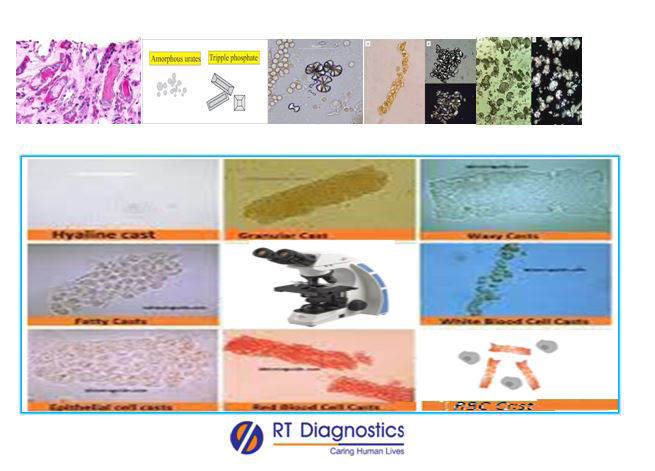Fluid for Cast & Crystal:
Why Fluid for Cast and Crystal Test?
CLINICAL INFORMATION
Urinary Casts and crystals: UrinaryCastsare tiny tube-shaped particles that can be found when urinary sediments are examined under the microscopic test called Urinalysis. Urinary casts usually consist of RBCs, WBCs, Kidney cells and it also constitutes minute aggregates of proteins (such as albumin in proteinuria), fats etc. Casts are cylindrical structures that are formed from coagulated protein (also referred to as “Tamm-Horsfall - mucoproteins” and/or “hyaline casts” – microscopic clusters of urinary particles with cells, fat bodies, microbes wrapped in a protein matrix as a cylinder is found in urine) developed in the distal convoluted tubule or the collecting duct and are secreted by tubular cells of the nephrons. Generally, in pathologies of kidneys, these casts are formed in plenty. These urinary casts can be of either cellular contents like RBCs, WBCs, Epithelial cells or of acellular/non-cellular contents such as hyaline, granular, waxy, fatty, pigment aggregates. Moreover, the urinary casts can be formed in combination of both cellular and acellular/non-cellular contents also. Hence urinary casts serve as clinical indicators of a kidney’s pathological condition. Some of the complications of urinary casts – increased accumulation of epithelial cell casts can lead to tubular necrosis. Urinary Crystals(also referred to as Crystalluria) are found during urinary tests known as Urinalysis. In some abnormal conditions crystals are formed in urinary sediments eg. Cystinuria (a condition with cysteine aggregates found in urine). Common types of crystals in urine include ammonium biurate, bilirubin, calcium phosphate, calcium oxalate, cysteine, hippuric acid, leucine, struvite (magnesium ammonium phosphate), tyrosine, uric acid, xanthine etc. On many occasions, these crystals get eliminated with ease without any symptoms (asymptomatic), while a few others become enlarged and form stones (eg. calcium oxalate, uric acid crystals etc) and get stuck in parts of the urinary tract and thus cause blockages. Risk factors of urinary crystals or stones include dehydration, change in pH, reduced intake of vegetables, fruits and high intake of red meat, fat-rich diet and salts in the diet. Complications include UTI, acute kidney injury, acute renal failure etc. Signs and symptoms of crystals in urine include pain, fever, cloudy or foamy urine, hematuria, bad-smelling urine etc. Body fluids such as intracellular and extracellular fluids are an accurate source of potential biomarkers as they have their ability to actively exchange certain biological factors between them i.e for example the lymphatic system, tissue interstitial fluid and blood plasma etc. The purpose of body fluids are to deliver nutrients and oxygen to all the cells of the body and remove the end products or toxic substances from the cells that are produced during the metabolism, to eliminate them out of the system by flushing them out of the body as urine, feces, sweat etc. Other functions of the bio-fluid/body fluids include maintenance of body temperature. When the body temperature increases, the blood circulation to the skin also instantaneously increases thus facilitating the dissipation of heat through sweating etc. The sample specimen is usually Intra-Vascular Fluid i.e Blood (serum/plasma) and/or body fluids. Body/Bio-Fluid Tests: Body Fluids include Peritoneal/Ascitic fluid (Ascites) – in peritonitis (inflammation of the lining of inner abdominal wall etc), Pericardial fluid, infected pleural fluid causing pleural effusion, Bronchial Wash, Drain or aspiration Fluids - Paracentesis, Thoracocentesis, aspiration of bone marrow, aspiration of amniotic fluid, JP Drain and /or blood, urine, saliva, sweat, bile fluid, seminal fluid, vaginal fluid, synovial fluid, nasal fluid, CSF, lymph, endolymph etc can provide a vital clue in the biochemical investigation of pathologies in certain disorders or disease conditions in certain differential diagnosis to arrive at a conclusive definitive diagnosis and also for prognosis.Significance of Cast and Crystal on body/Bio-Fluids test: Microscopic studies of urinary casts helps to diagnose conditions like tubular necrosis and Urinary crystals help in the confirmation of renal calculi and also help to identify the nature of crystal salt formed in it on further chemical analysis for stones. Other findings of crystals in fluid apart from urine specimen are the synovium for uric acid crystals. Mainly in patients with gout, these uric acid crystals are found in abundance and are the cause of inflamed big toes. Other additional tests include imaging studies: X-rays, CT-Scan, ultrasound etc.

General Instructions:
Sample Requirement: Specimen – Urine sample specimen and also in sample specimens like synovium for uric acid crystals – Gout etc (Hence sample specimen collection will be according to the physician’s guidance or the suggestions of a pathologist after clinical assessment). Test Preparation: None.
NOTE - Sample for specimen collections may vary based on the patient’s condition/cases according to the patient’s presenting complaints/signs or symptoms:
SPECIMEN REQUIREMENT (Special or Rare Cases) - As instructed and guided by Physician / Clinician / Pathologist / as per Laboratory’s requirements, according to procedures and protocols.
This Multi-Specialty Clinical Referral Laboratory RTDIAGNOSTICS provides precise and accurate tests with an extensive range of testing services to the medical centres to help in the diagnosis and identification of pathology in the test specimens for infectious diseases and also to evaluate the function of organ systems of the patient. It prevents further complications and helps to stabilize and restore health to near normalcy at the earliest without delay.



